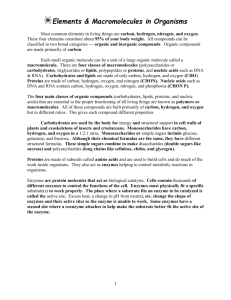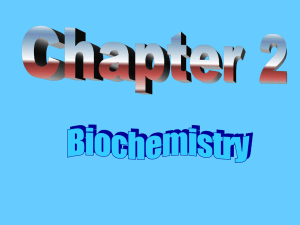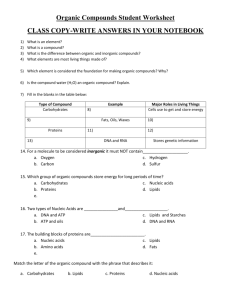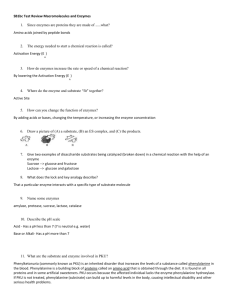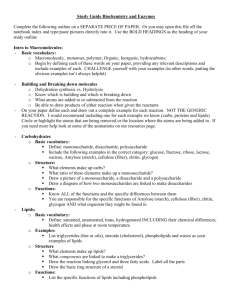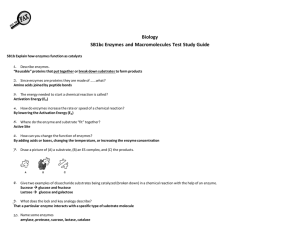http://www.quia.com/jg/77881.html
advertisement
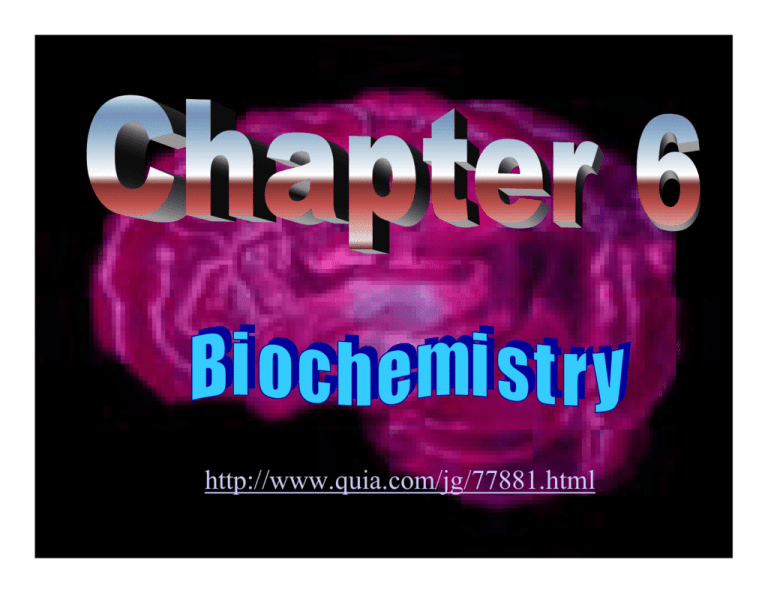
http://www.quia.com/jg/77881.html Kathryn Ferrara Saccone Per 6 10-27-00 Inorganic compounds include allthat do not contain carbon, and allthat contain simple carbon, but no hydrogen. They are found in living and nonliving substances. Organic compounds contain both carbon and hydrogen. Usually they also contain nitrogen and oxygen. They are found in living organisms. > Contains both carbon and hydrogen, and usually nitrogen and oxygen > Found only in the bodies or remains ofliving things > Each carbon atom forms four bonds with other atoms (usually double bonds,triple bonds are rare, yetexistent) > Carbohydrates,lipids, proteins and nucleic acids are four major types of organic compounds > Any compound that does not contain the element carbon is inorganic > Exam ples of inorganic compounds are carbon dioxide, calcium carbonate, water, salts, phosphates, bases and certain acids such as hydrochloric acid Four types of organic compounds will be discussed in this chapterCarbohydrates, Lipids, Proteins and NucleicAcids. Carbohydrates are compounds of carbon, hydrogen and oxygen in which the ratio of hydrogen to oxygen is 2 to 1. Simple sugars, or monosaccharides, are the simplestcarbohydrates. Examples ofmonosaccharides are glucose,fructose and galactose. Dehydration synthesis is a type of reaction in which two molecules are bonded together by the removal of water. Joining two monosaccharides by dehydration synthesis forms a disaccharide like maltose or sucrose. Many organic compounds are polymers that have long chains of repeating units. A polymer formed by joining many sugar molecules end to end is called a polysaccharide.Starch, glycogen and cellulose are examples of polysaccharides. A lipid is an organic compound, other than a carbohydrate, that consists of carbon, hydrogen, and oxygen. Lipids go by the common names, fats, oils and waxes. Lipids are formed from the combonation of fatty acids and glycerol. A fatty acid is an organic acid due to the fact that it contains a carboxyl group. Glycerol is an alcohol, or an organic compound that resembles a base in having one or more OH groups in their molecules. Glycerol has 3 OH groups in its molecule. The fats that are solid at room temperature are just referred to as fats. The fats that are liquid at room temperature are referred to as oils. If allthe carbon-to-carbon bonds are single bonds, thatfatis said to be saturated. If one or more pairs of carbon are joined by a double or even triple bond,they are said to be unsaturated fats.If a fat just has one unsaturated bond, itis known as monounsaturated. Ifit has more than one itis known as polyunsaturated. Unsaturated fats can be changed to saturated fats through hydrogenation, or adding hydrogen to it. W axes are formed by the combination fatty acids and alcohols other than glycerol. Cholesterolis a steroid found in most animal tissues. Itplays a role in the buildup of fatty depositsin arteries. Lipids have an extreme importance in many life activities. They are components of cell membranes along with other cell structures. Lipids also proviide a great energy supply and serve as cushioning and insulation for the Proteins are compounds that consist of nitrogen,in addition to carbon, hydrogen and oxygen.They serve as enzymes, antibodies, contractile material, hormones, pigments and structural partsin cells and tissues. Proteins also contain one or more chains of amino acids,the structural unitsof proteins.Glycine and alanine are examples of amino acids.Iftwo amino acids are joined by dehydration synthesis, a peptide bond forms between them. The resulting molecule is a dipeptide. A polypeptide is a chain of amino acids formed by a peptide bond. Enzymes are large, complex proteins. They make it possible for chemical reactions to occur in living cells.They are organic catalysts, because they can affect a reaction without being changed itself.An enzyme acts upon a substrate. The names of the enzymes usually ends with the suffix ase, and the name is often derived from the substrate. For example, maltase is the enzyme that splits one maltose molecules into two glucose ones. Somewhere on the surface ofan enzyme, there is an active site. The substrate molecules fitthe shape ofthe active site.It then forms atemorary union with the enzyme called the enzyme-substrate complex.The substrate may then break bonds within the substrate molecule and thus separate itinto two smallermolecules. This is called the lock-and-key model because the notched surface of akey can open only one lock,justlike the shape ofthe active site of an enzyme fitsthe shape ofonly certain substrates. • Small amounts of an enzyme can affect large quantities of a substrate • Enzymes enable cell reactions to proceed at normal temperatures • Enzymes work best at certain temperatures • Each enzyme works best at a certain pH • The rate of an enzyme-controlled reaction depends on the concentrations of enzyme and substrate • Some enzymes need substances called coenzymes, or a nonprotein organic substance necessary to the functioning of a particular enzyme, in order to function • Some enzymes function inside the cell, others act outside the cell. ORGANIC VS. INORGANIC •Compounds that contain both carbon and Hydrogen. •Examples: •Compounds that do not contain the combination of Hydrogen and Carbon. •C2H2=Acetylene •Examples: •C6H12O6=Glucose •H2O=Water •CO2=Carbon Dioxide •HCl= H. Acid 1)Carbohydrates 2)Proteins 3)Lipids (Fats & Oils) 4)Nucleic Acids (DNA & RNA) 5)Enzymes 1) Main source of energy for cell activities 2) 2:1 Ratio of Hydrogen to Carbon C6H12O6 3) Examples: Glucose (sugar) & Starch

